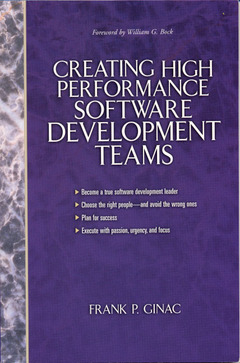Creating and leading high performance software development teams
Langue : Anglais
Auteur : GINAC Frank P.

This book offers powerful techniques for building high-performance software teams that deliver superior products, on-time and on or under budget. It focuses on the two most important elements of successful team building, people and leadership.KEY TOPICS:Frank Ginac offers a refreshing guide to assembling and leading teams that will create superior quality software from the ground up. Start by understanding what makes software developers tick, then discover the best ways to gain clarity about what your software development project is intended to accomplish. Learn how to identify the right people for your team -- and the wrong ones. Organize your software development team for success, fill gaps in your teams skills and experience, and identify the best ways to appraise individual and team performance. Prepare yourself to be a leader, not just a manager -- and avoid the barriers to leadership, including consensus-based management and corporate popularity contests. Learn how to plan successfully, and execute your plan with passion. Finally, go beyond planning to incorporate the best principles of software quality, from source code control to defect tracking and beyond.MARKET:For any manager or developer faced with the challenge of building and leading a software development team.
Foreword.
Preface.
Acknowledgments.
Introduction.
1. Nail Down the Requirements.
2. Build the Best Team.
3. Prepare the Team.
4. Prepare to Lead.
5. Planning.
6. Execute with Passion.
Preface.
Acknowledgments.
Introduction.
1. Nail Down the Requirements.
Purpose of Requirements. The Questions. Problem. What problem will the product solve? Opportunity. Who has the problem? How many have the problem? Window of Opportunity. When do they need a solution? Return. Is the product worth building? What is ROI? Calculating ROI. Requirements. How will the product solve the problem? How will customers use the product? Getting the Answers. Develop a Theme for the Project (Keep It Simple). Customers and Prospects. Competitors. Temper Requirements with Innovation. Example 1v1: Product Requirements Document.
2. Build the Best Team.
Piecing Together the Puzzle. Define the Team s Objectives. Hiring Profile. Culture. Personality. Track record. Knowledge, skills, and experience needed for success. Example 2-3: Hiring Profile. Hiring. Finding candidates. Do they fit? Sell the opportunity. Make them an offer they can t refuse. Close the deal fast. Organize Around Products. Traditional Hierarchical Organizations. What is a traditional hierarchical organization? Why they don t work. Flat Organizations. What is a flat organization? Why they don t work. A Better Way. Product development requires a cross-functional body of people. Create a cross-functional team. Appoint a leader with cross-functional responsibility.
3. Prepare the Team.
Eliminate Team Weaknesses. Individual weaknesses versus team weaknesses. Focus on determining team weaknesses. Harness Strengths. Fill In the Holes in Their Skills and Experience. Book studies. Formal training.
4. Prepare to Lead.
People Are People Not Resources. People Have Needs, Resources Need Maintenance. People Learn, Resources Are Programmed. People Quit, Resources Break. You Must Be a Leader Before You Can Lead. I m a Manager, Doesn t That Make Me a Leader? Classic distinction between manager and leader. Management is assigned, leadership is earned. Is It Possible to Be Effective If You Are Not a Leader? What does it mean to be effective? Leadership is a prerequisite for effectiveness. Do others see you as a manager or a leader? Perception is everything. Trickle-Down Effect of Leadership. Barriers to Effective Leadership. Popularity Contests. Politics. Bureaucracy. Prepare to Lead. Identify Your Weaknesses. Eliminate Your Weaknesses. Find a mentor and a coach. Fill in the holes in your skills and experience.
5. Planning.
By the Seat of Your Pants. Planning Is a Prerequisite for High Performance. There Is No Substitute for a Good Plan. Focuses Team. Informs Others. Identifies Dependencies. Anticipates Challenges and Offers Alternative Courses of Action. Project Planning Is Not an Exact Science. Task Breakdown Errors. People Are Unpredictable. Unforeseen Events. Aim for 80% Accuracy in First Version of a Project Plan. Don t guess. Develop the Plan. Step 1 Put a stake in the ground. Step 2 Specify the objectives. Step 3 For each set of related objectives, specify functional/design options. Example 5-1: Uni-Specification. Step 4 Select functional/design options. Step 5 Derive major tasks from selected functional/design options. Step 6 Identify dependencies. Step 7 Identify the critical path. Step 8 Identify mini- release points. Step 9 Assign people to tasks. Step 10 Level resources. Step 11 Adjust. Project Planning Tools. The Easy Part Is Done, Time to Execute.
6. Execute with Passion.
Execute . . . Keep It Simple. Work Your Project Plan. Lessons from SCUBA diving. The changing critical path. Keep your weakest performers off the critical path. Maintain Focus. Ask questions. Encourage. Motivate. Reward focusing behaviors. Reward results. Clear the path ahead. Accept no excuses. Manage performance. . . . With Passion. Think Like a Winner. Set high standards. Push the limits. Create a Sense of Urgency. What is it? What happens if you don t have it
- @SUBBULLET
Date de parution : 03-2000
Ouvrage de 286 p.
19x23 cm
Thème de Creating and leading high performance software... :
© 2024 LAVOISIER S.A.S.
